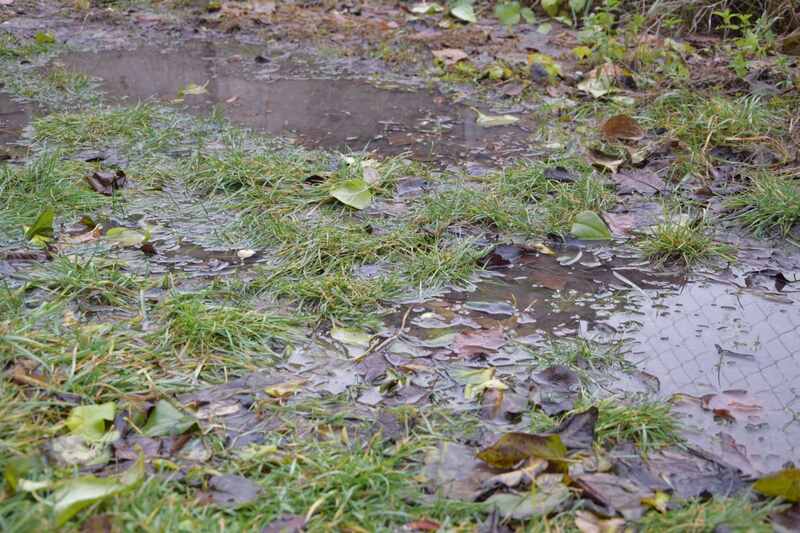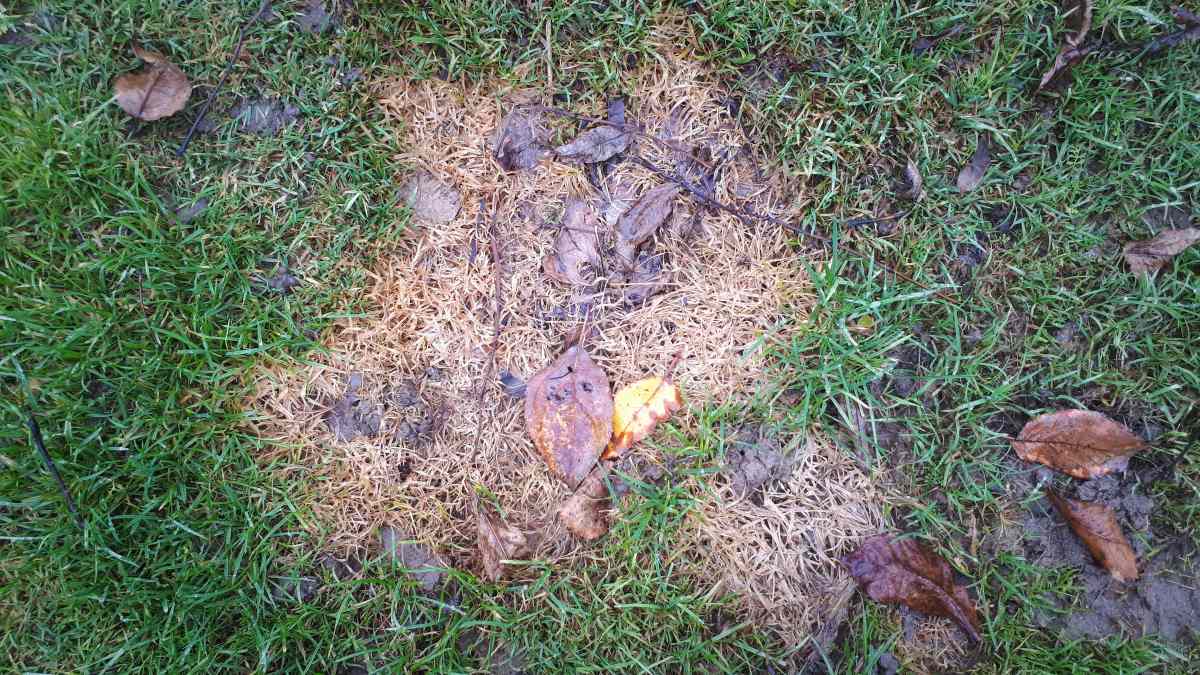
The best lawn winterization is proper fall lawn care, with a few adjustments just before winter: clean leaves off the lawn, mow until the grass goes dormant, and adjust or stop watering.
In this article, we discuss what tasks of fall lawn care impact your lawn’s resilience in the winter and what you need to do just before freezing and the first snowfall.
In this article, we cover the steps to winterizing your lawn:
- Remove Thatch Buildup
- Improve Drainage Around the Lawn
- Reseed and Overseed on Time
- Manage Fungal Diseases
- Remove Fallen Leaves and Debris
- Mow Until the Grass Stops Growing
- Adjust the Watering Schedule
- Check Soil Potassium
- Winterize the Lawn Equipment
- Other Ways to Winter-Proof the Lawn
- Keep a Strong, Healthy Lawn
Remove Thatch Buildup
Remove the thatch in early to mid-fall if it is thicker than 0.5 inches. It exposes the grass’s growing point to freeze and can suffocate the turf.
You would think that a soft blanket of thatch is welcome during the winter, but it’s not. Thick thatch elevates the grass’s growing point above the soil, exposing the plant to freezing temperatures.
It’s also harmful to grass trapped under dense layers of ice because it feeds soil microbes competing for the limited oxygen supply. This winter injury is known as ice encasement or anoxia – the grass suffocates and dies.
Dethatch cool-season lawns in early fall, but leave this task for the next spring if you’re growing a warm-season lawn.
Improve Drainage Around the Lawn
Fix compacted soil and low spots around the lawn in early to mid-fall. These areas pool water during thaws and expose the grass to freeze injury.

Water pools in low spots with compacted soil after this year’s first snow melts.
Early fall is a good time to make these repairs on cool-season lawns. If you grow Bermudagrass, St. Augustine, or Zoysia, leave aeration and leveling the lawn for late spring to early summer after they exit dormancy.
Here’s how you can fix soil drainage problems:
- Use a core aerator to make tiny holes in the ground and loosen the soil in compacted areas.
- Fill the low spots with good-quality topsoil and level the ground. In deep areas, added topsoil can cover the existing grass, but you’ll need to reseed it.
- Install a French drain or a swale to redirect snow and ice melt away from the lawn.
For more information about dealing with poor drainage in your yard, read our articles:
- “How to Tell You Have Compacted Soil”
- “How to Install a French Drain in Your Yard”
- “When and How Often Should You Aerate Your Lawn?”
Reseed and Overseed on Time

If you need to overseed a cool-season lawn, plant the grass in early fall to give it time to harden for the winter.
Fall is a good time to install new lawns and repair bare patches in existing ones, but timing is essential. Dr. Peter Landschoot, professor emeritus at the Penn State College of Agricultural Sciences, told us a common mistake homeowners make is seeding too late in the season, exposing young grass to harsh winter conditions.
“Our cool season grasses are pretty well adapted to most northern areas over the winter. However, if the seedlings are very young, like only a few weeks old, they can be killed over the winter. ”
The best time to overseed or install a new cool-season lawn is late August to early September. Overseeding is done on warm-season lawns from late spring to early summer.
Manage Fungal Diseases
Treat fall lawn diseases to ensure the turf enters the winter in good health.
Large patch disease, powdery mildew, and anthracnose are fungal infections to watch for once the temperatures drop and rainfall comes in the fall. Reduce soil moisture, improve airflow, and apply preventive fungicides to reduce their toll on the grass’s health.
Bermudagrass lawns are especially susceptible to Spring Dead Spot (SDS), a fungal disease that makes the grass more vulnerable to winter injury. If your lawn had it last year, apply preventive fungicides this fall.
Remove Fallen Leaves and Debris

Remove fallen leaves whenever they cover more than 20% of the turfgrass. They smother the grass and increase the risk of winterkill.
During fall, grass plants are busy preparing for winter. They use sunlight, water, and nutrients to grow their roots, make food reserves, and harden for the frigid winter temperatures. Fallen leaves block the sun and airflow, hindering their efforts.
Wet tree leaves also can promote snow mold and attract winter critters like voles and mice if trapped under the snow blanket.
Here’s how to remove fallen leaves effectively:
- Use a rake in small areas, but choose a leaf blower to clean a large lawn — you’ll save time and avoid blisters on your hands.
- Add the leaves to your compost pile, or use them as mulch on the garden beds or as bedding in the vermicompost bin (my little red wrigglers love dry tree leaves in their bedding).
- If there is a light leaf cover (less than 50% of the turfgrass), use a mulching mower to cut the leaves into tiny pieces and mulch them into the lawn. They make for a nice natural fertilizer.
Mow Until the Grass Stops Growing
Don’t stop mowing too early in the fall. You’ll make lawn care much harder in the spring.
“The grass will be very matted when the snow melts, and then you have to rake it up because it doesn’t stand back up again,” said Dr. Landschoot.
Schedule the last mow of the year when the grass stops growing because of the cold weather. This happens about the time all the leaves have fallen from the trees. You’ll want to put a rush on it if there’s a heavy snow forecast to mow before snow covers the lawn.
Cool-season grasses stop growing and go dormant when soil temperatures drop below 45°F. This happens early to mid-November up north and late November in the transition zone.
Down south, warm-season grasses enter dormancy when soil temperatures drop below 55°F. In the transition zone, that is late October to early November, but down south, the last mow can be postponed up to December. In South Florida, the mild winters keep the grass growing, and mowing is required less often but doesn’t stop.
How tall should your grass be entering the winter season? Dr. Landschoot said 2 to 3 inches is a good mowing height to leave the grass at during winter. “There’s no real reason to lower the mowing height down to below 2 inches.”
Adjust the Watering Schedule

Grass and soil lose less water when it’s cold. In mid-to-late fall, ensure your lawn receives about ½ inches per week, including rain (or snow).
The Northeast has rainy autumns and snowy winters. Dr. Landschoot said homeowners in places like Pennsylvania typically don’t need to water their lawns in the fall. There are exceptions, though. In dry years, such as 2024, watering might be prolonged until mid-October.
“Once the snow comes and the grass is semi-dormant, there’ll be plenty of moisture in the ground for the turf to green up next spring.”
Things are different in the Central and Southern U.S., where dry falls and winters are common, and sprinklers stay active until late fall. As a rule of thumb, the lawn should receive one to three-quarter inches of water per week until dormant. You should generally stop watering the lawn with the last mow before the soil freezes.
Here are some basic rules for watering the lawn in late fall to avoid harming the grass:
- Check soil moisture and only water if the top few inches are dry.
- To prevent freeze injury, avoid watering the lawn 24 to 48 hours before an expected frost.
- Once night temperatures approach freezing, winterize the sprinkler system. If necessary, continue irrigation with a sprinkler and a garden hose.
If you experience a dry winter lasting more than four weeks without rain or snow, you must water the lawn lightly to avoid winter desiccation. Apply a quarter to half an inch of water every two or three weeks. Do it during warm spells and apply water mid-morning, when temperatures rise above 40°F, to ensure it’s absorbed until night.
Check Soil Potassium
“I always recommend that homeowners do a soil test before they go out and buy an expensive fertilizer because soil tests are usually inexpensive,” said Dr. Landschoot.
Potassium is an essential nutrient for cold hardiness, which you must test the soil for in the fall. “It acts like an antifreeze, like putting polyethylene glycol in the radiator of your car,” said Dr. Landschoot. “If you do a soil test and it shows a deficiency of potassium, then you definitely want to be applying that in the fall.”
Apply a potassium fertilizer at least six weeks before the first frost for good results. Choose:
- a product with 2:1 or 1:1 nitrogen-to-potassium ratio for cool-season grasses (e.g. an N-P-K ratio of 20-0-10 or 10-0-10)
- a product with only potash (e.g., N-P-K ratio of 0-0-60) for warm-season grasses.
Dr. Landschoot warns against applying heavy nitrogen fertilizers late in the fall to cool-season grasses. Excess nitrogen can force new growth and make the grass more susceptible to snow mold disease and freeze damage.
Warm-season grasses should not be fertilized with nitrogen later than August.
Winterize the Lawn Equipment
Lawn Mower
Remember to winterize the mower after you have cut the lawn to ensure it works properly in the spring.
Dr. Landschoot advises homeowners to avoid letting gasoline in the tank over winter because it can cause problems. “You can take it out of the tank, and what’s left in there, just turn on the mower and let it run out of gas if you’re going to be storing it outside or in a cold area.”
Read all the winterizing instructions in our guide, “How to Winterize Your Lawn Mower”
Sprinkler System
The irrigation system is also at risk, as it can crack if water freezes inside its pipes and fittings. To prevent this, turn off the water supply and the timer, drain the water, and insulate exposed components. See all the steps in our “How to Winterize Your Sprinkler System” guide.
Other Ways to Winter-Proof the Lawn
- Winter topdressing: If you live in an area with dry winters, apply half an inch of sand topdressing to prevent the grass from losing water and dying of winter desiccation.
- Protective covers: Protect warm-season grasses with fabric covers when temperatures are expected to go below 25 degrees Fahrenheit. Add extra insulation (hay or straw under the cover) if you expect freezing temperatures of 15 degrees and lower.
- Windbreaks: Plant windbreaks or install fences on the north side of the lawn to protect it from strong winter winds.
- Divert traffic: Plant shrubs or install fences to divert traffic off the lawn during winter.
Keep a Strong, Healthy Lawn
Proper lawn care in the fall is the secret to less winter damage and a beautiful spring lawn. It’s easier when pros do it! Find a lawn care professional with LawnStarter and enjoy a healthy, spotless lawn without the hard work.
Sources:
- Hutchens, W.J., Carr, T.Q., Patton, A., Bigelow, C. A. (2024, August). Management strategies for preventing and recovering from bermudagrass winterkill. Crop, Forage & Turfgrass Management. DOI:10.1002/cft2.20302
- https://www.researchgate.net/publication/383424077_Management_strategies_for_preventing_and_recovering_from_bermudagrass_winterkill
- Unruh, J.B. (2014).Turfgrass Trials and Tribulations. University of Florida. https://wfrec.ifas.ufl.edu/media/wfrecifasufledu/docs/pdf/turfgrass/GCGCSA_11102014_Unruh.pdf
- Vavrek, B. (2016, August 5). Winterkill – Causes and Prevention. Green Section Record Vol. 54 (15), pag. 1-6. https://gsr.lib.msu.edu/article/vavrek-winterkill-8-5-16.pdf
Main Photo Credit: vencav / Adobe Stock Free / License




